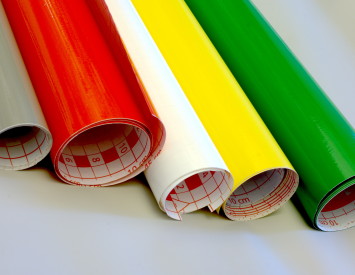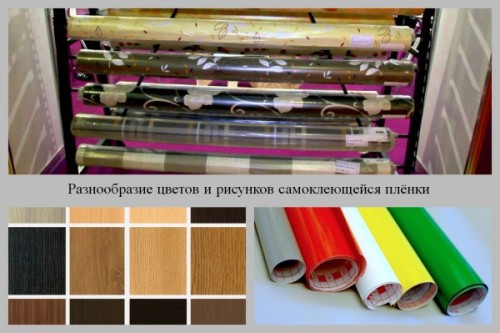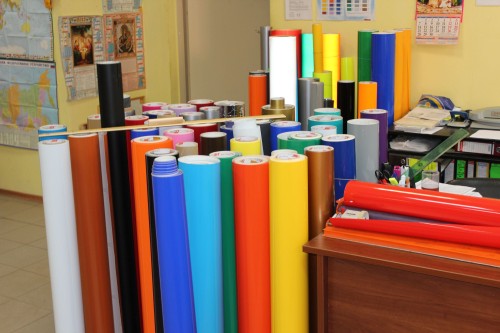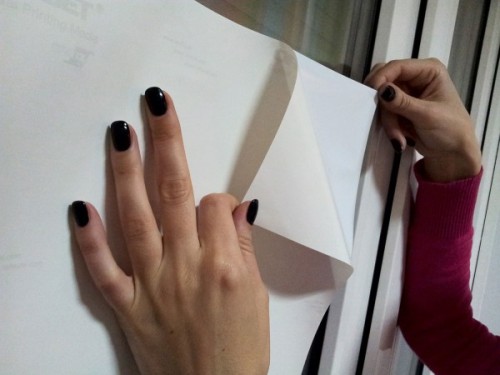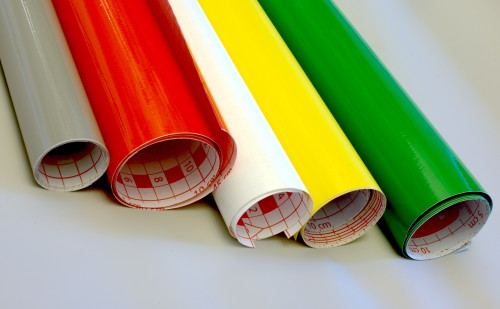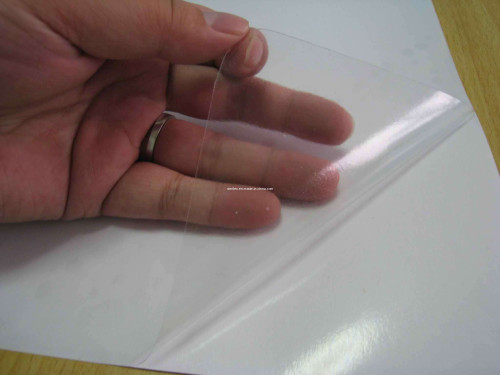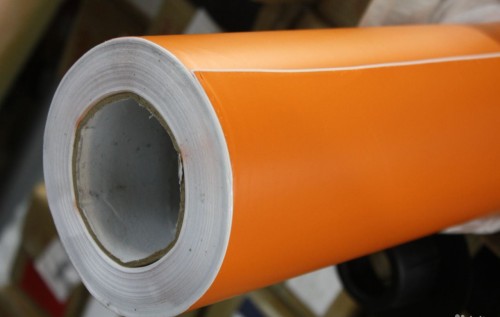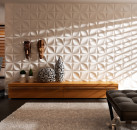A self -adhesive film is one of the easiest ways to change the environment around you. It is often used in interior decoration. This is facilitated by the simplicity of its use, cheapness, wide color scheme and a large selection of various drawings. It should not be forgotten that this material has its own characteristics and requires a certain approach to work. About how to properly glue a self -adhesive film we will tell further.
Content
Characteristics of the material
Today on sale you can find many types of self -adhesive films for various surfaces. So, it can be intended for gluing furniture, cars, walls of the room. All of them have something in common, namely the fact that the manufacturing technology is used in the manufacture. Due to which this material combines the qualities of adhesive tape and wallpaper.
Of the advantages of "self -adhesive" it is worth noting the following:
- Moisture resistance.
- Simplicity of use.
- Resistance to high temperatures.
- A variety of textures and drawings.
- Low cost.
- Lightness of care.
In addition, this material can be applied to almost any surface. Whether it is drywall, metal, plastic, wood, glass, cork, ceramic tiles or plywood. A self -adhesive film on furniture looks especially good.
Only you need to immediately prepare for the same complexity, which is the main disadvantage of this material. This is the need to align the surface when pasting. If you do not eliminate all the irregularities, then the film will begin to exfoliate over time or undesirable defects (bubbles) will appear on the wall.
All that you need during work is patience. If you need to overlay a large surface, then the assistant will not interfere.
Features of work with the material
Consider where this material is used:
- Due to its qualities, such a film can be used in almost any room. So, for example, it is allowed to glue in a kitchen with high humidity. Here it will help to update the interior without any special costs, and will also maintain cleanliness and comfort.
- A self -adhesive film will be by the way in a house where there are small children. After all, they like to draw, and on any surface. With such a material, you can easily erase traces of paint or felt -tip pens. If everything cannot be completely removed, then the film can always be replaced with a new one. This will cost much cheaper than overflow of wallpaper.
- A self -adhesive film for the bathroom and toilet is also well suited. Here she will help protect the walls from excess moisture and spray of soap water. After all, from the film they can be easily wiped.
- This material is also suitable for a children's room. And it doesn’t matter what age you have. Perhaps the baby himself will help you choose a more suitable coloring of “self -adhesive”.
- A modern assortment of a self -adhesive film allows you to update the appearance of the room and even completely change the style by pasting some interior items.
If you decide to choose a film, then first of all, consider which surface it will glue on. So, for example, a material with mosaic patterns is suitable for glass, and a transparent self -adhesive film for ancient furniture.
As already mentioned, one of the advantages of this material is the simplicity of leaving. For this purpose, warm water and detergent are quite enough. Just do not use cleaning powder substances and solvents. The fact is that these funds can damage the structure of the film and its color. To remove stable pollution, it is best to use ethyl alcohol.
Obviously, a self -adhesive film can be called universal material that allows you to change your house at low costs as you yourself will want. To update the appearance of your home, it is not at all necessary to change the situation. A self -adhesive film will help to make your life brighter.
How to glue a self -adhesive film
Tools
From the tools you will need:
- Ruler.
- Pencil.
- Scissors.
- Installation knife.
- Fleet spatula.
- Construction hair dryer. It is important to warm with it a glued film around the perimeter.
Preparatory work
Before gluing a self -adhesive film, you first need to prepare the surface. We offer some tips on how to do this:
- The surface that is subject to pasting should be cleaned well, degreased with gasoline or alcohol, and then dry thoroughly. The easiest film is applied to a smooth wall with varnish coating. If the surface has a roughness or dullness, then it is better to cover it first with soil or polyester varnish. In addition, instead of it you can use wall -out methyl glue.
- The surface of plywood, wood, chipboard, fabric, plaster should first be cleaned well of the dust and particles of the material. If necessary, use putty or acrylic primer. Thanks to this, the film will last much longer.
- Before glue the film onto a metal or glass surface, the base should first be slightly moistened.
Cutting the material
In order to correctly cut the film into pieces, on the back of the material a mesh is applied with a step of 1 cm. If there is no such marking, then it can be applied independently, not forgetting to leave the supply of a couple of centimeters. For cutting, scissors or a special knife are most suitable.
In general, the process of cutting a self -adhesive film has its own characteristics. So, for example, if the pattern on the material is made in the form of tiles, then it is best cut at the seams. If the film has a pattern with a rapport, then it is cut on the front side.
A sticker of such material does not require much time. The most important thing is not to rush and be very neat. This will help to avoid many mistakes when working with a self -adhesive film. A tree is one of the best materials on which the film is perfect to go.
Stages of gluing
- When the pattern is ready, the film can be separated by about 50 mm from the paper substrate, then the sticky side should be applied to the pasted surface. It is important that the size and shape coincide.
- Now, without haste, you need to gradually separate the rest of the film from the film. At the same time, the material should be carefully distributed over the surface, smoothing with a rag made of soft dry fabric.
- To avoid the formation of bubbles, it is desirable to smooth from the center to the edges of the canvas, i.e. as well as when pasting wallpaper. These are the main works when using a self -adhesive film. The photo below shows an approximate final result.
- Errors made during pasting should be corrected immediately. The film must be leveled on the surface until it grabbed completely. Otherwise, all the work will have to be done again.
- If you need to glue a fairly large area, then the surface that will be processed should absorb moisture well. The wall should be cleaned and dried, covered with a layer of wallpaper glue and until it has dried, distribute the film on the surface, not forgetting to fit the material in size. Then you need to iron the film with a soft dry cloth.
- Some types of such films are very quickly grasped with the surface, which can be very uncomfortable when working. It is especially difficult to adjust such material in size. To slow down the sticking of such a “self -adhesive”, you can use powder and talc. If air bubbles occur, then they should first be pierced, and then gently smoothed.
- If you need to paste a metal or glass surface with a film, then it should first be moistened with water, adding a small amount of detergent or soap solution to it. This tool helps to properly fit the film on the necessary sizes. After that, the material is completely separated from the paper substrate. Then it is carefully applied to the wet surface. And finally, dry with a sponge or a soft cloth.
How to remove a self -adhesive film
After some time, the film glued in due time may be bored. Then you will want to change it to something new. In this case, the old material will have to be removed. Moreover, it must be removed correctly without damaging the surface. So, how to do it correctly:
- First, it’s better to try to use hot water for this purpose. So, the surface is thoroughly wetted, after a few minutes it is recommended to separate the film, using some sharp object. Only you need to be neat and not damage the surface on which it is applied.
- If hot water did not help, then you can try to use a hair dryer. To do this, the film must be warmed up properly. Thanks to this, glue can disconnect from the surface. It is best to use an industrial hairdryer, but it is also allowed to use a regular household hair dryer.
- A similar principle of operation is the heater with a fan. Therefore, it is also suitable for filming the film. To do this, it is put to maximum power and directed to the surface with which you want to extract the material. Gradually, the film will become softer. When this happens, pry one angle and carefully pull the layer in your direction until it completely separates.
After removing the film on the surface, most likely the glue particles will remain. They can be removed using a solvent, gas or alcohol. The choice of fluid depends on the surface of the surface.
You can learn more about how to glue a self -adhesive film on the video:
